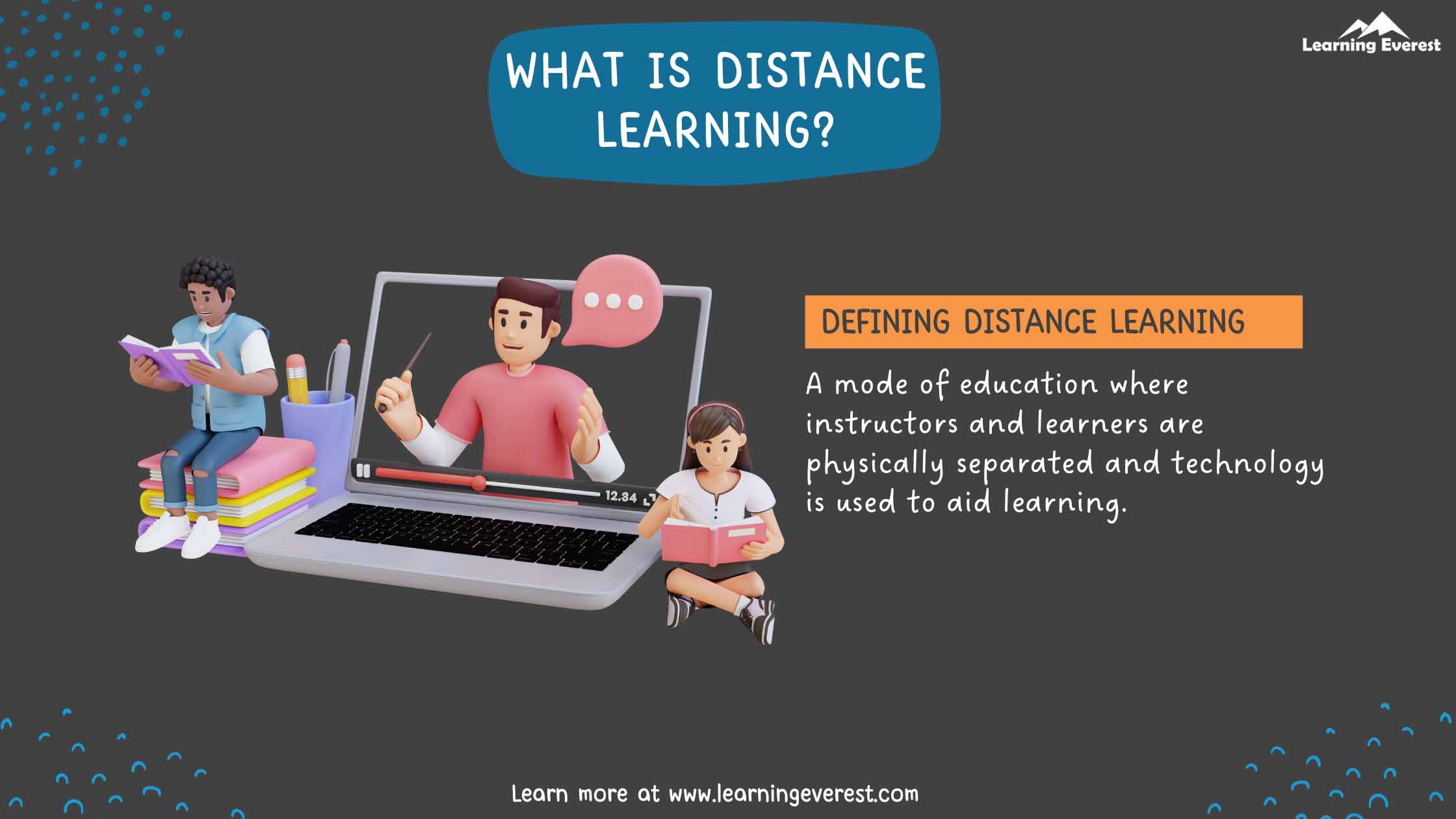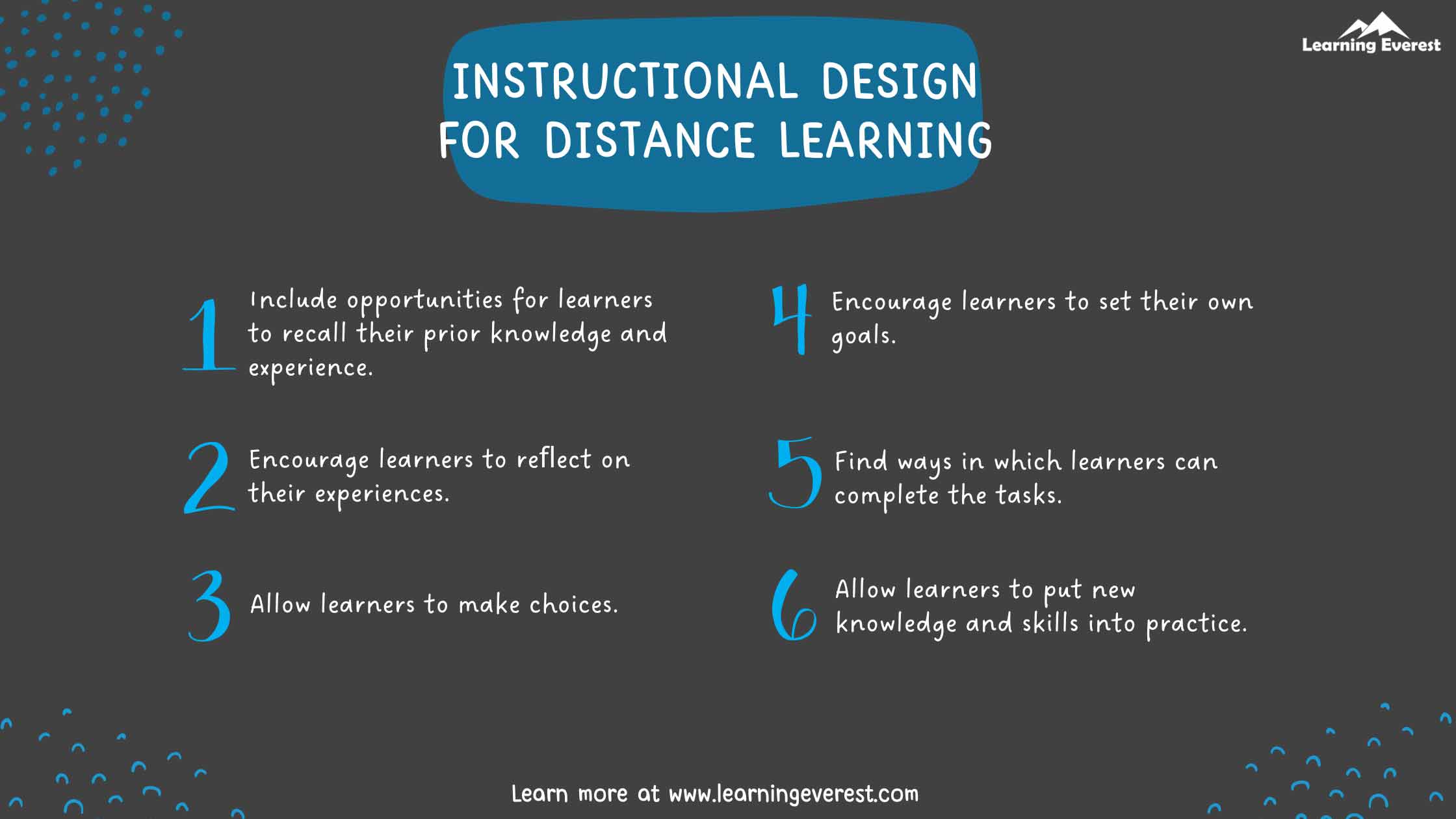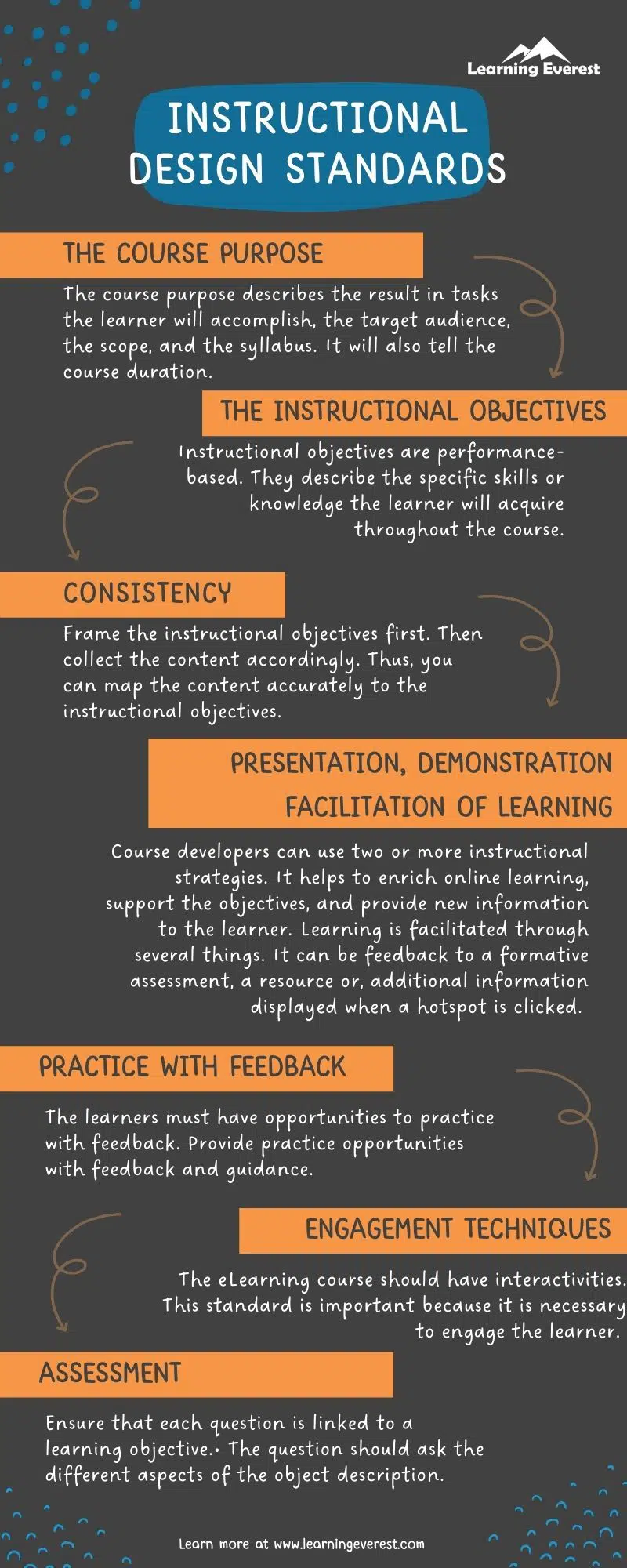Instructional designers follow specific standards while creating e-learning courses. Thus, they can create courses that are educational and engaging. It starts with researching the material-based particular needs of the client. The instructional designer decides how to present the course. Though instructional designing is much work, it is a successful teaching method.
Table of Contents
Distance learning materials are prepared either by individuals or small teams. These teams consist of curriculum designers, instructional designers, and people with skills like web design and tutorial support.
Creating Distance Learning Content
The following members in an organization make the distance education materials:
- an instructional designer who is the content provider and the writer
- an instructional designer who converts text provided by a teacher
- a team of people, including content providers, instructional designers, and audio and video producers
What is Distance Learning?

What is Distance Learning?
According to britannica.com, “distance learning, also called distance education, e-learning, and online learning, is a form of education in which the main elements include physical separation of teachers and students during instruction and the use of various technologies to facilitate student-teacher and student-student communication.”
Merriam-webster defines distance learning as a method of study where teachers and students do not meet in a classroom but use the Internet, email, mail, and more to have classes.
What Is Instructional Design for Distance Learning?
Instructional design works systematically. It translates learners’ needs and goals into successful learning.
In classroom-based teaching, the teacher is the primary reso urce of knowledge. However, the teacher remains the system’s central component because a teacher defines what is taught, provides information, explains, sets learning tasks, checks what the students have learned, and provides extra resources and feedback. They also give support and study advice to learners.
On the other hand, learning materials and tutors replace teachers in distance learning. The tutors are involved with the learners only for a short period. Learning materials are designed to carry out the tasks of a teacher. The learning materials themselves define what is to be learned, provide information, and more in distance learning. Therefore, instructional design for distance learning is a complex task.
What Does An Instructional Designer Do?
An instructional designer typically does the following tasks:
- Determine learning needs analysis
- Develop learning objectives
- Decide learning assessment during and at the end of the course
- Allocate outcomes to the different sections of the course
The Instructional Designer must also do the following:
- Decide the types of activity to achieve the learning outcome
- Choose the necessary examples to help learners learn each outcome
- Identify graphics when needed
- Plan self-assessment required
- Write the units
- Evaluate the materials
Adult Learning
It is essential to keep in mind the adult learning characteristics while designing eLearning modules for the learners in your organization. The following are the most commonly quoted characteristics of adult learners:
- Adults want to know why they should learn: Adults put effort into a task if they think it will benefit them. Therefore, the distance learning content must be beneficial to adult learners. They must be able to apply at home and work practicably.
- Adults see themselves as responsible, self-directed persons: Adults tend to see themselves as responsible for directing their own lives. They like to set their own goals. They want to choose their learning tasks in education.
- Adults come to learn with a wealth of experience: Adults will have much experience and will likely view education while they are employed as building on those experiences.
- Adults want to choose to learn when they are ready to learn: Adults are unlikely to enroll in courses before they feel prepared to follow them. Adult distance learners tend to be highly motivated: they study what they want and have clear personal goals.
- Adults are goal-oriented: Adult learners tend to be goal-oriented. The course must assist adult learners in achieving their goals.
- Adults are motivated by personal factors: Adults learn to meet individual needs such as greater job satisfaction or a better quality of life.
Implications For Instructional Design In Distance Learning

Instructional Design for Distance Learning
The instructional designers need to emphasize the following approaches when designing distance learning courses for adults:
- Ensure that you include opportunities for learners to recall their prior knowledge and experience.
- Encourage learners to reflect on their experiences and compare them with what they are learning.
- Design courses according to the needs of learners. The learners must understand why they are learning a particular course.
- Allow learners to make choices and direct their own.
- Encourage learners to set their own goals.
- Find ways in which learners can complete the tasks.
- Allow learners to put new knowledge and skills into practice.
Embedded Devices
Martens fashioned the term ’embedded devices’ in 1998. It describes all the devices that instructional designers include in their materials. The most common materials he looks at include learning objectives, prior knowledge tests, advance organizers, activities, feedback to exercises, examples, self-tests, summaries, lists of key points, study tips, animations, and hypertext links.
Why do instructional designers include embedded devices in Distance Learning materials?
Instructional Designers does so because the cognitive approach stresses the use of learning devices such as:
- Learning objectives
- Learners assessed against the learning objectives,
- Tasks within the scope of the stated objectives
- Material ‘chunked’ into small pieces,
- Organizers to help learners see the structure of the topic
At the same time, the distance learning courses a few factors based on constructivist approaches such as:
- Real-world tasks
- Learner choice of situation
- Case studies
- The complexity of the world presented in the tasks
- Collaborative learning tasks
- Opportunities to learn from observing others
- Self-evaluation
Instructional Design Standards
As the courses are for diversified learners, it is important to follow certain standards. Instructional Design Standards observe the connection between the course objectives, content, methods, and the learner.
- The Course Purpose: The course purpose explains the outcome of the course in terms of knowledge and skills. It describes the result in tasks the learner will accomplish, the target audience, the scope, and the syllabus. It will also tell the course duration.
- The Instructional Objectives: The course should state its learning objectives. Instructional objectives are performance-based. They describe the specific skills or knowledge the learner will acquire throughout the course.
- Consistency of Objectives with Content: The content of your eLearning course must align with its objectives. Frame the instructional objectives first. Then collect the content accordingly. Thus, you can map the content accurately to the instructional objectives.
- Presentation and Demonstration: Course developers can use two or more instructional strategies. It helps to enrich online learning, support the objectives, and provide new information to the learner. Thus, learners internalize, synthesize, and apply further details. It emphasizes how the content should be presented and demonstrated.
- Facilitation of Learning
-
- Learning is facilitated through several things.
- It can be:
- feedback to a formative assessment
- a resource
- or an additional information that is displayed when a hotspot is clicked
- Practice with Feedback
-
- The learners must have opportunities to practice with feedback.
- Provide practice opportunities with feedback and guidance.
- Allow learners to apply the newly acquired knowledge.
- Ensure that feedback is constructive.
- Mostly, the learner is just told whether the answer is correct or not. But, the learner wants more.
- Tell the learner why the answer is correct.
- Thus, learning is reinforced.
- If the answer is wrong, provide the learner with the right solution in a subtle manner.
- Engagement Techniques
-
- The eLearning course should have interactivities. This standard is important because it is necessary to engage the learner.
- There should be ample interactions.
- Developers should be creative while developing them.
- A wide variety of interactivities are available in the authoring tools.
- Assessment
-
- Ensure that each question is linked to a learning objective.
- The question should ask the different aspects of the object description.
- The assessments must be in sync with the learning objectives of the online course.
Instructional design is a systematic process where instructional designers turn the written form into a more visual form of learning. Instructional designers provide training material and close knowledge gaps with clear and meaningful content. In order to meet the needs of the diversified workforce, the instructional designers at your workplace must follow specific standards.
Infographics
Knowledge Check!
Frequently Asked Questions (FAQs)
What is instructional design for distance learning?
Several instructional designs are used to communicate information to students in distance learning. Instructional design is connected with the development of courses. It improves the learning experience of the learners.
What are instructional design standards?
The following are the instructional design standards:
- The Course Purpose
- The Instructional Objectives
- Consistency of Objectives with Content
- Presentation and Demonstration
- Facilitation of Learning
- Practice with Feedback
- Engagement Techniques
- Assessment
What are the key elements of instructional design?
The following are the key elements of instructional design:
- Analyzing the needs of learners and organization.
- Determining instructional goals and objectives.
- Constructing a method for evaluating learner achievement.
- Designing and selecting instructional strategies.
- Implementing the training.
- Evaluating the training.
What are the best tools in instructional design?
The following are the best tools in instructional design:
- Articulate Storyline
- Adobe Captivate
- iSpring Suite
- Lectora Publisher
- Robohelp
What are the key characteristics of good instructional design?
The characteristics of good instructional design are the following:
- It is a student-centered and goal-oriented process.
- It focuses on meaningful learning experiences.
- It assumes outcomes are measurable.
- It is typically is a team effort.






